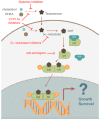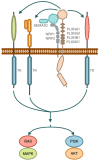Semaphorin 3C as a Therapeutic Target in Prostate and Other Cancers
- PMID: 30759745
- PMCID: PMC6386986
- DOI: 10.3390/ijms20030774
Semaphorin 3C as a Therapeutic Target in Prostate and Other Cancers
Abstract
The semaphorins represent a large family of signaling molecules with crucial roles in neuronal and cardiac development. While normal semaphorin function pertains largely to development, their involvement in malignancy is becoming increasingly evident. One member, Semaphorin 3C (SEMA3C), has been shown to drive a number of oncogenic programs, correlate inversely with cancer prognosis, and promote the progression of multiple different cancer types. This report surveys the body of knowledge surrounding SEMA3C as a therapeutic target in cancer. In particular, we summarize SEMA3C's role as an autocrine andromedin in prostate cancer growth and survival and provide an overview of other cancer types that SEMA3C has been implicated in including pancreas, brain, breast, and stomach. We also propose molecular strategies that could potentially be deployed against SEMA3C as anticancer agents such as biologics, small molecules, monoclonal antibodies and antisense oligonucleotides. Finally, we discuss important considerations for the inhibition of SEMA3C as a cancer therapeutic agent.
Keywords: SEMA3C; cancer therapeutics; inhibitors; neuropilins; plexins; semaphorins.
Conflict of interest statement
The authors declare no conflict of interest.
Figures





Similar articles
-
Androgen receptor transcriptionally regulates semaphorin 3C in a GATA2-dependent manner.Oncotarget. 2017 Feb 7;8(6):9617-9633. doi: 10.18632/oncotarget.14168. Oncotarget. 2017. PMID: 28038451 Free PMC article.
-
Semaphorin 3 C drives epithelial-to-mesenchymal transition, invasiveness, and stem-like characteristics in prostate cells.Sci Rep. 2017 Sep 13;7(1):11501. doi: 10.1038/s41598-017-11914-6. Sci Rep. 2017. PMID: 28904399 Free PMC article.
-
Semaphorin 3C and Its Receptors in Cancer and Cancer Stem-Like Cells.Biomedicines. 2018 Apr 8;6(2):42. doi: 10.3390/biomedicines6020042. Biomedicines. 2018. PMID: 29642487 Free PMC article. Review.
-
SEMA3C induces androgen synthesis in prostatic stromal cells through paracrine signaling.Prostate. 2021 May;81(6):309-317. doi: 10.1002/pros.24107. Epub 2021 Jan 27. Prostate. 2021. PMID: 33503318
-
Emerging roles and mechanisms of semaphorins activity in cancer.Life Sci. 2023 Apr 1;318:121499. doi: 10.1016/j.lfs.2023.121499. Epub 2023 Feb 10. Life Sci. 2023. PMID: 36775114 Review.
Cited by
-
Identity of MMP1 and its effects on tumor progression in head and neck squamous cell carcinoma.Cancer Med. 2022 Jun;11(12):2516-2530. doi: 10.1002/cam4.4623. Epub 2022 Apr 14. Cancer Med. 2022. PMID: 35426219 Free PMC article.
-
Analysis of immune related gene expression profiles and immune cell components in patients with Barrett esophagus.Sci Rep. 2022 Jun 2;12(1):9209. doi: 10.1038/s41598-022-13200-6. Sci Rep. 2022. PMID: 35654816 Free PMC article.
-
Dependency of Tamoxifen Sensitive and Resistant ER+ Breast Cancer Cells on Semaphorin 3C (SEMA3C) for Growth.Cells. 2023 Jun 25;12(13):1715. doi: 10.3390/cells12131715. Cells. 2023. PMID: 37443749 Free PMC article.
-
The Anti-Tumorigenic Activity of Sema3C in the Chick Embryo Chorioallantoic Membrane Model.Int J Mol Sci. 2019 Nov 12;20(22):5672. doi: 10.3390/ijms20225672. Int J Mol Sci. 2019. PMID: 31726800 Free PMC article.
-
Construction and validation of a prognostic signature based on microvascular invasion and immune-related genes in hepatocellular carcinoma.Sci Rep. 2024 Nov 6;14(1):26994. doi: 10.1038/s41598-024-78467-3. Sci Rep. 2024. PMID: 39506070 Free PMC article.
References
Publication types
MeSH terms
Substances
Grants and funding
LinkOut - more resources
Full Text Sources
Medical

